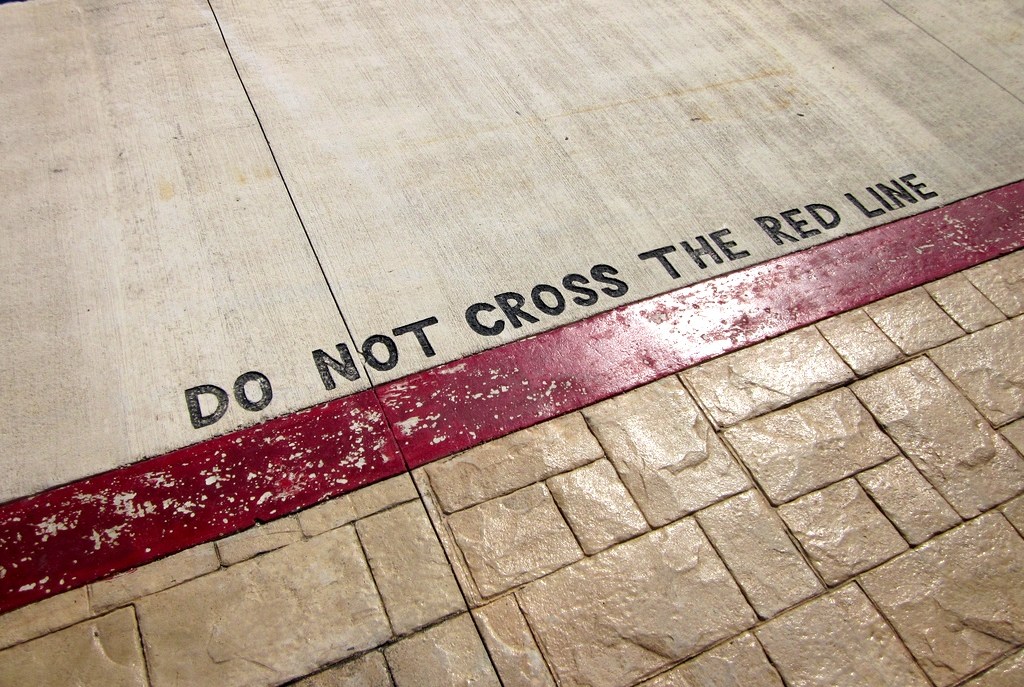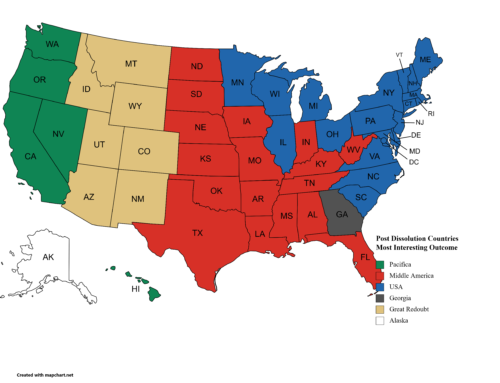Over the past several years I’ve asked a lot of people in relaxed conversations what their red lines are. In nearly every case, my conversation companion is taken aback by the question. The concept of red lines isn’t something they think about. But here’s the rub for every one of us. We all have red lines in nearly every aspect of life. And those red lines bring necessary consequences. So lets talk about what red lines are and then what the implications of those red lines mean to your business and life. Then we’ll close with some practical recommendations for your own red line considerations.
A red line is the point on the continuum of an issue beyond which you won’t go. This is really important because you have red lines in all aspects of life, whether or not you think about it. I have to emphasize that deliberately considering your red lines across multiple areas of life and business is far better for you as leaders than facing a situation and looming red line.
A simple example would be the abusive boss or CEO that crosses the line at which point you quit. The boss crossed a line beyond which you stepped away rather than continue in the relationship even if it meant losing your position and having to look for a new job. That is a scenario which nearly everyone has either seen or can envision.
Perhaps a bit more difficult to conceive is a moral red line. Lets say you are the legal counsel to a tech company in a hub out West. You tell your boss that the new software update will clash with the corporate mission and vision. The CEO tells you he will accept the risk and you move forward. Then 6 months later the company decides to offer the software to a country that it had heretofore said it wouldn’t sell to because of human rights concerns in that country. You remind the CEO that this sale would cross the corporate red line of allowing the software to be used by authoritarians against their own people. The CEO tells you that he is confident the country will only use the software to protect their country from outside threats, rather than against their own people. If you question the CEO’s premise, then you have to make a decision about whether to be OK with crossing the red line. The red line didn’t move. You have to decide whether or not you will be part of the process of crossing it. If you’re OK with it, then you must consider the very real possibility that you’ll be OK with anything beyond that line. The CEO could always remind you that you’d already accepted a red line crossing, so why not the next.
What these hypothetical scenarios show us is that red line crossings are not a yes/no, either/or, black or white episode. Each red line is somewhere on a continuum between absolute zero and infinity within of possible values of an issue. That means that for an issue such as free speech, almost nobody has a position in which all speech is acceptable or all speech is open to abridgment. For most people, there is a position somewhere on that continuum beyond which they believe governments should abridge speech. Yelling fire in a crowded theater is not acceptable to most people. But the precise spot on the scale of each issue is private.
Another point to consider is that your personal red line may differ slightly in location on the continuum from what society (in the form of norms) or government (in the form of laws) sets as red lines. Most people will accept the risk of a speeding ticket, and inherently, whether deliberately decided or not, the risk of an accident, by routinely driving faster than the posted speed limit. We can see this in how people vary in how much faster than the speed limit individuals routinely drive. People show their red line in speed very consistently. You have your 5 mph over people and your 9 mph over people. But we know hardly anyone who drives in varying speeds over or under the speed limit depending on the day. The point is that people set their own red lines despite what the law or social pressure says the red line ought to be.
Here is what I think is the most interesting issue with red lines. A person’s theoretical position on a red line might come into conflict with that person’s practice. There are many people who advocate for the rewriting of zoning laws which restrict low-income housing to specific areas, thus clustering poor people, and the likely incidence of crime. But a large number of those advocates also live in highly segregated communities in which poor people, or people that don’t look like them, could never hope to live in. In another example, there are vast numbers of people who hold up the founding words of Republic that all men are created equal who actually vary widely on what they believe “all men” and “equal” mean.
This last point is significant because as leaders we are all observed on a daily basis by people within our organizations and people outside them as well. You, as a leader, need to set your red lines and you need to know where your red lines vary from social norms. You should also realize that people will look at both what your stated red lines are as well as what the evidence shows on how you actually act. That means the public will hold you to account both if your practice deviates from your stated red line and if the public believes your red line is wrongly set.
Some tech companies are under fire because their red line on use of the platform by autocrats to influence their societies is far lower than what the general public thinks is acceptable. Some tech companies say they don’t want police to use their data to make arrests, yet this activity comes into conflict with the actual openness of those platforms themselves. If platforms state that they don’t want the government to use their platform to find people who break the law, that is an unenforceable red line, because you are providing a space for people to show what they’re doing, whether illegal or not. Furthermore, the mean public response to your red line will vary by the type of law the state uses your platform to crack down on. For example, your software platform may enable trafficking in children just as easily as it allows protesters to coordinate in cities. The public would readily support law enforcement to use your platform to crack down on child traffickers. The public might not accept police using your platform to crack down on peaceful protesters, but may accept police using it to crack down on violent protesters.
It is up to you to think through the implications of your business, your red lines and whether your red lines vary from the public’s mean on that same issue. For example, all US military officers take an oath of office to support and defend the Constitution of the United States. Most red lines are easy to see and know the consequences of. There are often clearly written red lines in military law. Don’t fly in your jet if you’ve been drinking within 12 hours. Clear red line. Don’t kill your commanders. Clear red line.
But what about the vaguely defined red lines, such as the use of force which is proportional to the importance of the target. My research over the last 20 years shows how the variance in that red line affects combat operations. Individual leaders will vary on whether a potential target is attacked and by what weapons. That decision can be different from day to day in combat operation based on who is on duty at the time that decision is made. How that order is accepted and carried out can vary widely as well by those assigned to carry it out. Some pilots will argue that if the order is given, the process would not allow an unlawful target or munition to be assigned. Others will fly the mission but purposely drop the bombs away from the target or non-combatant populations. That happens far more than people know. And finally others will refuse to fly the mission and accept any punishment that comes.
Such is the nuance and variance of red lines. I strongly urge you all to consider your red lines long before you come to it so that you recognize it when you get there. In 2006, Orson Scott Card told an audience of 600 military and civilian leaders from the US and 78 countries that none of them really knew if they meant it when they took their oath of office. There was a lot of squirming in the audience and some really angry responses. Then he told the audience that Robert E. Lee and James Longstreet took the same oath of office and yet fought against the US Constitution and against the US Army to which they were sworn.
His point then is the same I make today. It behooves a leader to deliberately ponder your red lines in all areas of your business and life. If you’re a lawyer, can you accept working for a mob boss as a consigliere? If so, you have to realize that once you say yes, it is almost impossible later on to say no. If you are a folk music group that accepts a gig for a Russian oligarch’s daughter’s wedding, you have to consider that it might not be possible to say no in the future. Your initial yes will have implications on your life for years to come.
On the other hand, if your red line is set really low you may make yourself irrelevant in an important issue. For example, if you are a pacifist and think that all violence is immoral, then your red line is so low that you cannot be included in any discussion of options for dealing with violence that may require something greater than no violence.
I agree with Orson Scott Card that it is important for you as a leader to think through all the possible issues that could cause you to trip over a red line before the situation presents itself. This is where a leadership team ought to seriously consider hiring a Chief Analyst to help you think through the implications of where you place your red lines. It is also a good, and I’d argue necessary, activity for Friday afternoons over beverages before everyone heads out for the weekend. Gather your leadership team and throw out a scenario and ask how the team would handle it. I can almost guarantee you that your team will have some significant variance on both where you ought to publicly set your red line as well as whether you actually follow through with where you publicly set it or whether you deviate from it in the real-world situation.
I remember Kevin Holzimmer, a Professor of History, listening to a conversation and argument about the issues surrounding where the US ought to set red lines diplomatically and militarily in the Middle East and Central Asia in a Washington, DC forum. In the end he asked the participants,”But what are you actually going to do?” That is is the key. You have to think it through so that when the situation presents itself, you will have already done the hard work and can fall back on that time of deliberate reflection and go with what you set out to do. The alternative is to constantly be surprised by each situation, having to go through your calculus on the spot.
You might think that you have a strong moral compass, and you probably do! You might think that just having a strong moral compass will make it easy to make the right decision whatever the situation that arises. In practice, that is almost never the case. Your moral compass can get you close to the right answer, but thinking through the implications takes time. And you know from reading prior posts how I feel about thinking through implications ahead of decisions.
This current pandemic shows us how people put into practice their red lines. Those who wear masks while alone in their car tell you their red line for risk is much higher than those who don’t wear masks at all. And that doesn’t even begin to address the issues surrounding who can afford to set their red lines based on their social and financial status. But even then, you as a leader have a responsibility for those under you by how you set your red lines on when people can and must come to work. If your red line is that you’ll fire someone who doesn’t show up for work, you will end up being ultimately responsible for those who would otherwise stay home if sick, but come to work for fear of losing their jobs, and then make people around them sick. In any industry in which people work in close quarters, that risk increases.
So you have a restaurant with a tight kitchen that needs its cooks to show up. And you don’t want them to come to work sick to infect other workers or the food they’re preparing. But you also don’t want them just claiming sickness and staying home. This is an issue to think about before you open your restaurant, not when everyone is calling in sick.
Here’s a challenge: find a small group of friends or colleagues to discuss this topic with over beverages or a Zoom call some time. Pick an area of life and see where everyone sets their red line and then discuss the implications of that. You might be surprised by both the intensity of the discussion and how malleable some peoples’ red lines are.
Let me know if you have any thoughts on this subject. I’d love to hear from you.
Keep thinking…






Leave A Comment